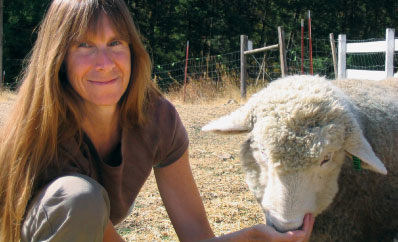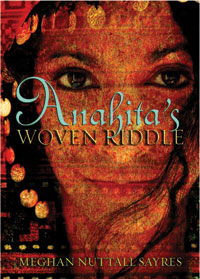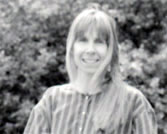
|
|
About Continuum Advertising Advisory Committee Archives Contact Us Continuum Home Faculty/Staff Subscribe related websites Alumni Association Marketing & Communications University of Utah Home |

BookshelfWeaving a LifeMeghan Nuttall Sayres writes as she lives: colorfully, creatively, and interconnectedly.by Marcia C. Dibble Ten years ago, Meghan Nuttall Sayres MPA’94 wrote a short story about a 19th-century Iranian girl who, faced with an undesired impending marriage, convinces her father to let her hold a contest in which potential suitors must correctly answer a riddle she has woven into her bridal carpet. Sayres sent the story to a publisher who told her, “You have so many characters here, you might try turning this into a novel.”
Last year, that onetime short story at last made its debut as the young adult novel Anahita’s Woven Riddle (published by Amulet Books, an imprint of Harry N. Abrams, Inc.), quickly receiving industry recognition with inclusion on lists such as the Winter 2006-2007 Children’s Picks List by Book Sense and as a Young Adult Library Services of America nominee for the Best Young Adult Books List 2006; most recently, it was chosen by the American Library Association as one of its 2007 Top 10 Books for Young Adults. Sayres also saw another decade-long project come to fruition in 2006 with the publication of her nonfiction coffee table book Weaving Tapestry in Rural Ireland (released by Cork University Press in Ireland and sold in the U.S. through Dufour Editions), which combines the oral history, essays, and contemporary art of tapestry weavers in Donegal, Ireland, with elegant black and white photographs of the region’s landscape. Sayres clearly knows how to spin a yarn. But the two books are even more intertwined than most might immediately recognize. Besides the common thread of weaving—a passion of Sayres’s, who herself raises sheep, spins and colors her own fibers with natural dyes, and weaves tapestries—the Irish and Middle Eastern cultures depicted in the two works share a number of surprising commonalities. Sayres’ interests are similarly far-reaching yet interwoven; curious and independent, she reads, writes, and travels widely. Of Irish heritage, Sayres’ parents visited Ireland often while she was growing up (“We were steeped in it,” she recalls), and at age 14 or 15, she made her first trip there, a monthlong bicycle jaunt to Glencolmcille, Donegal, with her sister and three other teenagers. (She returned there this January for the book launch of Weaving Tapestry.) Sayres first went to Turkey in 1985, backpacking by herself around the country and neighboring Greece, and has returned to both countries several times. And she recently paid her first visit to Iran, for an international children’s book festival. In traveling to the southeastern part of the country, she witnessed the destruction from the catastrophic 2003 earthquake that killed and injured tens of thousands of people and left much of the historic Silk Road city of Bam in ruins; some of the proceeds from Anahita are now going to a development project for Iranian women who survived the quake. Other experiences from this visit helped inform Sayres’ sequel to Anahita (she just finished a first draft). “I wasn’t ready to leave the characters yet, which led me down some interesting roads in terms of Iranian history,” she says. “Many people I’ve spoken with didn’t know that Iran began to form a parliament in 1906, or that they have a kind of democratic government today. And Tehran alone had about 70 newspapers in the early 1900s. How about that for a variety of voices to hear? I touch on these aspects of civic dialogue and plurality in the sequel.” Sayres began writing creatively while pursuing an MPA in International Rural Development at the University of Utah in the late ’80s. “I was writing a lot of papers in graduate school, and always trying to spice them up with human interest stories—even throwing in quotes and dialogues,” she recalls. “Then, when I had children and started reading to them, I began getting some ideas, and realized I had stories to tell.” After migrating to the Southwest from her native Pennsylvania to pursue her undergraduate degree at the University of Colorado-Boulder (drawn initially for the skiing as much as for school, she says), Sayres had discovered the rich Native American history of the region. As she learned about the natural pigments used in these early peoples’ well-preserved pictographs and fabrics, as well as ancient regional Native American arts such as weaving yucca plants into sandals, she began to actively cultivate an interest in natural dyes and handmade textiles. Her first published article was about the restoration of the Buckhorn Wash rock art panel, which ran in the Castle Dale, Utah, newspaper over two Sundays in the early 1990s (“Reed Martin [a local who was very involved in the restoration] just called up the newspaper and suggested it,” she recalls, “It was very long-winded”). But before long, she began focusing her burgeoning interest in dyeing and textiles specifically on tapestry weaving, both Irish and Oriental. Sayres had come to know the weavers of the Taipeis Gael cooperative during her many forays to Ireland, and she began volunteering with the cooperative, helping arrange for the weavers to display their handiwork and attend conferences in the United States, and writing magazine articles about the women and their work. She dove headfirst into shepherding, spinning and dyeing when she moved to the Spokane, Wash., area in the early ’90s (“I didn’t know where I could raise sheep in the Avenues,” she quips), finding numerous mentors for the crafts there. And in her travels in Turkey—and more recently, Iran— she met with carpet weavers, dye masters, and merchants to learn more about their practices and traditions. “I’ve always loved Oriental carpets, been fascinated with them, and I bought one of my own 10 or 15 years ago, an Afshar tribal rug woven in Iran in about 1930,” she says. “It’s marvelous, with all these patterns in it: roosters, which, like birds in general, are considered [in the Middle East] to be amulets against the evil eye… and the colors mean different things. Red means happiness, while blue sometimes represents eternal life.” Her Afshar rug became the model for the one woven by her character Anahita. “Women in that part of the world still weave dowries, and the Persians have a penchant for riddles, so I put those together as a plot for the story.” “For millennia, women have told stories in rugs,” she notes. “While historically, many have been illiterate, weaving has always been another form of expression.” Sayres currently has various children’s picture books in the works, along with a historical fiction piece called Nettie’s Red, set on the island of Inis Mor in the West of Ireland during an uprising in the late 1800s. Like Anahita, this young adult novel also grew out of an earlier short story, the award-winning “Nettie’s Charm.” “Nettie is a weaver, and the red [in the title] is the red that she dyes, but the book is not predominantly about that at all,” says Sayres. “It’s set after the famine but before Ireland gained independence from Britain, when many tenants were involved in uprisings. In this story, I explore what it would take to make somebody pick up a stone [as a weapon]. Nettie, a young girl, struggles with that.” Since the release of Anahita, Sayres has given readings from the book (along with showing slides from her trip to Iran) in Ireland as well as western American cities including Seattle and Sacramento. “And I would love to come to Salt Lake,” she says. “I have hopes that [Anahita] would be read by Salt Lake young adult book clubs. “I still feel a little bit like Salt Lake is home,” she muses. “I really enjoyed living there, and my kids were born there. I might one day come back—I’ve had my eye on the Middle Eastern Studies program, and my youngest this year graduates from high school… so who knows?” —Marcia C. Dibble is assistant editor of Continuum |
Observations on IranFrom her experiences in Iran, Sayres notes of that country: “I don’t think it’s as intellectually restrictive as we are led to believe. I was interested to see how well-educated the women are. Most women in their 20s and 30s have two or three degrees, and their mothers did, too. And even as I traveled from Tehran to Isfahan to Kerman, toward the Afghan border [and the epicenter of the 2003 earthquake]… the students I met were talking about whether to be civil engineers or electrical engineers. So people are not just educated in Tehran.”
Sayres notes that roughly 25 to 40 percent of children’s books
in Iran are foreign translations, and that a bookseller in Tehran told
her that 10 times as many foreign-translated novels are published in
Iran than books by native writers, while PEN America reports that less
than three percent of books in the U.S. are foreign translations. She
also recounts meeting an Iranian librarian who noted that even the region’s
nomads are often avid readers—the librarian shared photos of herself
taking books out to nomads’ enclaves in saddlebags on the back
of motorcycles. “So, although we have a vision of Iran as isolationist,
they seem to be more widely read, in terms of world literature, than
many might have thought,” says Sayres. Another Chapter
After receiving her undergraduate degree in Recreation Therapy at UC-Boulder, Meghan Nuttall Sayres came to the University of Utah in the hopes of establishing a department in her specialty. Trained in spinal cord injury rehabilitation, and with a deep love of skiing (“I had been living in Durango, and Utah was definitely a step up,” she notes), she wanted to bring those skill sets and passions together for a new community. "It took a year, working in the physical therapy department as a physical therapy aide," she recalls, "but I started organizing recreational outings for patients—head injury, spinal, and stroke patients—volunteering time… and the dream came true." Not long after creating the Department of Recreation Therapy, Physical Rehabilitation Services, at the University of Utah Health Sciences Center, Sayres started a family (her husband, now a family practice doctor, was doing his residency at the U), and left physical therapy to focus on her children. But her restless mind took her back to the U of U in 1988, when she created her own curriculum for her MPA, combining occupational health, international healthcare issues, and international relations. She finished her dissertation for the degree after her family relocated to Spokane. Just another chapter in the intriguing story of this accomplished, determined woman.
|

 “I’m
finding more and more connections between Ireland and the East,”
Sayres says. “The Irish language is closer to Berber than Indo-European,
and a lot of customs are similar between Iran and Ireland.” She
shares an anecdote described in Bob Quinn’s book The Atlantean
Irish. The Gaeltecht, the Gaelic-speaking region of the West of
Ireland (where Sayres has lived and traveled extensively), has a tradition
of sean-nos singing, which is usually men, most often singing
an a capella lament. Quinn writes that in the Caucasus, a visitor heard
singing that he thought sounded just like sean-nos, so he taped
it, and brought it back to Connemara, a district in the Gaeltecht, to
share— “and the men finished the tune,” says Sayres.
“Not the words, but the exact same tune. And there are very similar
name spellings and pronunciations. In Farsi, the girl’s name Shirin
is pronounced ‘SheeREEN,’ and that the ‘i’ is
pronounced as ‘ee’ is similar in Irish. I find this all
very interesting. It’s not surprising, though. For centuries,
the Atlantic was a major trade route from the East, and traders came
right up the coast of Ireland to Iceland.”
“I’m
finding more and more connections between Ireland and the East,”
Sayres says. “The Irish language is closer to Berber than Indo-European,
and a lot of customs are similar between Iran and Ireland.” She
shares an anecdote described in Bob Quinn’s book The Atlantean
Irish. The Gaeltecht, the Gaelic-speaking region of the West of
Ireland (where Sayres has lived and traveled extensively), has a tradition
of sean-nos singing, which is usually men, most often singing
an a capella lament. Quinn writes that in the Caucasus, a visitor heard
singing that he thought sounded just like sean-nos, so he taped
it, and brought it back to Connemara, a district in the Gaeltecht, to
share— “and the men finished the tune,” says Sayres.
“Not the words, but the exact same tune. And there are very similar
name spellings and pronunciations. In Farsi, the girl’s name Shirin
is pronounced ‘SheeREEN,’ and that the ‘i’ is
pronounced as ‘ee’ is similar in Irish. I find this all
very interesting. It’s not surprising, though. For centuries,
the Atlantic was a major trade route from the East, and traders came
right up the coast of Ireland to Iceland.” Sayres’
other works for children include the nonfiction book The Shape of
Betts Meadow (named a 2002 John Burroughs Nature Book For Young
Readers), which tells the story of the restoration of a wetlands near
her home in eastern Washington, and several pieces in the collection
Daughters of the Desert: Stories of Remarkable Women from Christian,
Jewish and Muslim Traditions, depicting fictionalized accounts
of events in the daily lives of descendants of Sarah and Hagar, the
most significant women in the early years of the interconnected Abrahamic
faiths. She has also contributed to the adult nonfiction collections
Midlife Clarity: Epiphanies from Grown-up Girls and Crazy
Woman Creek: Women Rewrite the American West, and is completing
a poetry collection, Between Deserts, which “explores
rooted and uprootedness; belonging and yet not belonging to the places
we dwell physically, mentally, spiritually.”
Sayres’
other works for children include the nonfiction book The Shape of
Betts Meadow (named a 2002 John Burroughs Nature Book For Young
Readers), which tells the story of the restoration of a wetlands near
her home in eastern Washington, and several pieces in the collection
Daughters of the Desert: Stories of Remarkable Women from Christian,
Jewish and Muslim Traditions, depicting fictionalized accounts
of events in the daily lives of descendants of Sarah and Hagar, the
most significant women in the early years of the interconnected Abrahamic
faiths. She has also contributed to the adult nonfiction collections
Midlife Clarity: Epiphanies from Grown-up Girls and Crazy
Woman Creek: Women Rewrite the American West, and is completing
a poetry collection, Between Deserts, which “explores
rooted and uprootedness; belonging and yet not belonging to the places
we dwell physically, mentally, spiritually.”